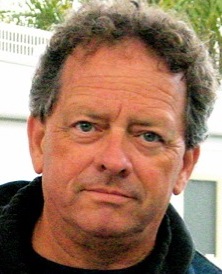The Windhook Interview—Amy McKay
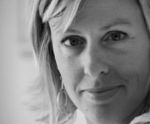 Amy McKay was on a traditional career path in landscape architecture until the economy threw her, and the entire construction and architectural design industry a curve beginning in 2008. She followed that curve right into her life's passion and is now painting in her own studio space and showing and selling regionally. Her story is about closed doors. Her story is about opening your own doors. The choices Amy is making add up to a remarkable example for artists trying to find their way in this tough economy.
Amy McKay was on a traditional career path in landscape architecture until the economy threw her, and the entire construction and architectural design industry a curve beginning in 2008. She followed that curve right into her life's passion and is now painting in her own studio space and showing and selling regionally. Her story is about closed doors. Her story is about opening your own doors. The choices Amy is making add up to a remarkable example for artists trying to find their way in this tough economy.
Amy paints and shows in San Luis Obispo, California where she lives with her husband, Lief, and their two young children.
Michael: So how long have you been doing art? Is this one of those things where you grew up knowing you were going to do it?
Amy: Yeah, and then when it was time to go to school I want to say I chickened out. I was too scared—you know, lack of confidence. There would be a lot of people better than me. What if I couldn't get a job. Or I just wasn't good enough. So I just went to community college for a few years and then I found landscape architecture and that combination of creativity and creating outdoor spaces really appealed to me because I grew up camping and hiking.
Peggy: Where did you grow up?
Amy: In Auburn, California. So the Sierras were kind of my backyard. I painted on and off over the years but never very consistently. You can make all kinds of excuses—you're too busy. And then you have kids. And I was too busy before that. And then a few years later, when people at RRM was dropping like flies, It occurred to me that I could be next. There's no other work in landscape architecture around here at the moment and I thought I'd better figure out what I would do instead. And if I had to do it over again, painting is what I'd always come back to.
So I just started talking to people about this idea of having a studio and making a go of it. I could either wait until I'm retired and my kids are grown up and do it then, or by that stage I could look back and be glad I'd been painting for the last thirty years and also be an example to my kids that this is a passion and I went for it and just somehow made it happen. So it was amazing when this studio actually came to fruition—these four walls.
Michael: You've sort of touched on this in your reference to RRM, but this economy seems like it's had a real profound effect on a lot of people and specifically increased people's willingness to take that chance. How much of an impact on your decision process was the precariousness of having a "real job"?
Amy: I don't think my studio would exist if the recession hadn't happened. Because I would have just been working along and everything would have been like planned and it would have still been out there in the future some day. But if I'm hardly working, what do I have to lose?
Michael: So were you part-time at RRM?
Amy: Yes.
They had the option to cut back my hours without letting me go. They laid off people and then they went to this "call-off" so my regular hours were three days a week. Every Friday I would check the schedule and if they had the work I would come in, and sometimes they didn't, so that day would be a call off. There were some weeks when there was nothing. I could sit around at home feeling really stressed and really down about this or I could make the most of my time. It was one of those turning points where I just decided that it's worth the risk.
My kids were usually at school. Maggie just started kindergarten, but before that she was at pre-school. I couldn't just keep her home for a week to save money because she would lose the spot. That was hard because I wasn't working, and financially it was a stretch. But at the same time I needed to keep her there, so I suddenly had time by myself at home, which is rare. So whenever I had call offs I just looked at it from a positive perspective—great, I'm going to be in the studio, and I've got a plan.
Michael: So tell us about the studio and how it came about?

Amy: My friend Shelly who lives just over the field. She really inspired me to just do it. We went to Home Depot and looked at those sheds out front to see what was possible for what kind of money. And then I looked at Don Seawater's place, Pacific Coast Lumber. I looked at his little sheds, and it was a little bit more than I could afford because they build it off site and bring it in. But I didn't like the sheds at Home Depot so...
I looked to my friend, Bill Isaman, who's an architect, and asked him to give me his best costs, material wise—what would this cost to build? His estimate was less than what the Home Depot sheds cost, but obviously that didn't include any labor. But we didn't pay for labor. Little by little as we talked to people, someone would say, "well I can help you with this," or "my husband is a contractor and he has a couple windows sitting in the garage." And little by little it just came together.
Peggy: Had you ever built anything before?
Amy: No. We set a date for something like a barn raising weekend and a couple of weeks before that we dug out the foundation.
We built it on 6 x 12 pressure treated beams. That's a great foundation for a little building like this.
Amy: We looked at doing concrete. But because we don't own the property, the landlord didn't want a permanent structure. So the beams were down and the floor joists were down and all the material had been delivered. And then we had Saturday and Sunday with 8 guys—friends, and my uncle came from Eugene. They all had some building experience and one friend is a contractor locally. So he was a huge help. By lunchtime that first day it was totally framed out.
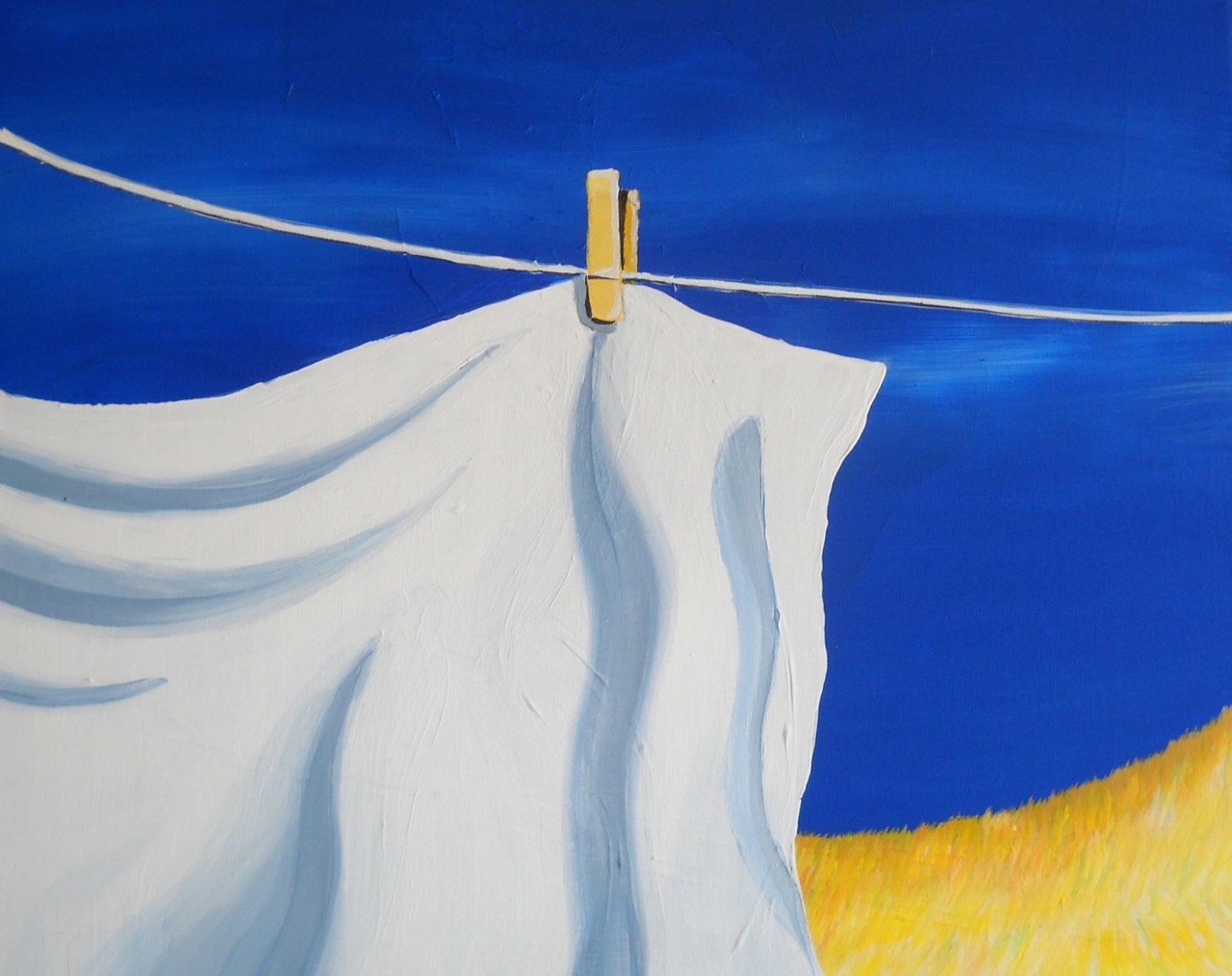
Michael: Very early on in this process of making the transition, you settled on having a separate, well defined studio space apart from your living space. Some people try to do it in their garage or spare room or living room.
Amy: Oh yeah, it's my woman cave and all my friends are jealous. I've painted in the living room and we have 900 square feet so that isn't very effective. I mean the family was tolerant of it and I tried to clean up and move it to the side a little when I was done but I still never painted very effectively unless Lief and the kids were gone. Something happens from the back door to the door of the studio. On that walk, it doesn't matter what's going on in the house or what kind of day I've had or if the house is a disaster and there's a bunch of chores to be done. I leave all that behind.
Peggy: Do you keep a schedule?
Amy: It comes and goes. Last year I was coming out to the studio Monday and Wednesday evening. And that works really well because he knows, the kids know, by 6:00 I'm out here and I can work for a good 3 hours. It actually works out really well, because especially on a bigger painting, 3 hours is a good amount of time before I start screwing something up. And I'll get to a good stopping point it's almost time for bed, I feel good about what I've done and can walk away from it for a few days. The kids aren't allowed in here when I'm not in here, and normally they're not allowed at all. They know it's not a play space. So it really is my little sanctuary.
Michael: It sounds like you've really established a balance between your family time and your work time and you've got a guy who supports you in that.
Amy: Yeah it's true, he's very supportive. After we had that barn raising weekend, Lief and I basically spent every weekend for the the next year out here figuring out how to do the siding, figuring out how to do everything—we were learning as we went. He put in a lot of hours with me on this. But the balance isn't quite there. If I didn't have another job, everything would have it's place.
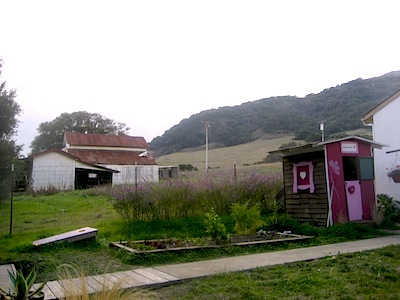
Michael: So about how much time is involved with your job and compared to your time doing this.
Amy: I work 20 hours a week and when I get home it's kid time. I pick them up from school, we're doing homework, after school activities. Ian is third grade and Maggie started kindergarten and I pick her up at noon.
So ideal world—Maggie's in school full time, I don't have to go to a job five days a week. I'd have from 9-2 out here painting—then I'd feel like I filled that part of my spirit, and then when the kids came home I could feel like I could be present with them and everything would be right with the world. It gets a little crazy sometimes squeezing it in, but I don't have any regrets about the time I spend out here.
Along the lines of balance and finding the time, I find that entering shows and having a deadline is key. When I don't it's more challenging to set my own deadlines for things and make sure that it happens.
Michael: So you're kind of a deadline driven person.
Amy: I'm not very disciplined. I have a show at Linnea's in July and I don't have a very big body of new work for it at the moment, so I'm pretty much creating everything for that show. At the moment it feels that's a good amount of time to get
everything done. We'll see how disciplined I am at creating a new piece every two weeks.
Peggy: So a solo show? Before, you had a solo and a group show there, right?
Amy: I did a couple group shows and a couple pieces are there now. Yeah the first time I showed at Linnea's was a solo show, which was really nerve wracking.
Peggy: Had you shown before that?
Amy: I had never had my own show. So that was intimidating. I think psychologically it's been a challenge for me getting to that point where I can say I'm good enough and I deserve to have that kind of attention. That's been a high hurdle for me. That idea of "just me?" All my work and then the reception too! Leading up to the reception, I was really nervous, and I'd rather just be a fly on the wall.
Peggy: But you're it, you're the show.
Amy: Yeah, and then a funny thing happened—I really loved it! The room was full of people and everyone wanted to talk to me. I'm not usually comfortable in that situation, but I think it was just confirmation that this is what I'm supposed to be doing. Because even in that scenario it was comfortable, It was like this is right. It was fun.
Michael: That's a very interesting problem that a lot of people have with self confidence. The impostor syndrome is a thing a lot of artists suffer from. The idea that "If they really knew, would they still like me."
Amy: Or if I didn't see anybody else's work would I be producing what I'm producing now. Is it really my own idea?
Michael: Now that touches on one of Peggy's favorite questions: "Where do you get your inspiration?" But before you answer I want to make one comment I've heard it said that everyone in the arts plagiarizes everyone else at some vague level. It's as if no ideas are really new—we feed off of each other's ideas. Maybe it's why community is so important to artists.
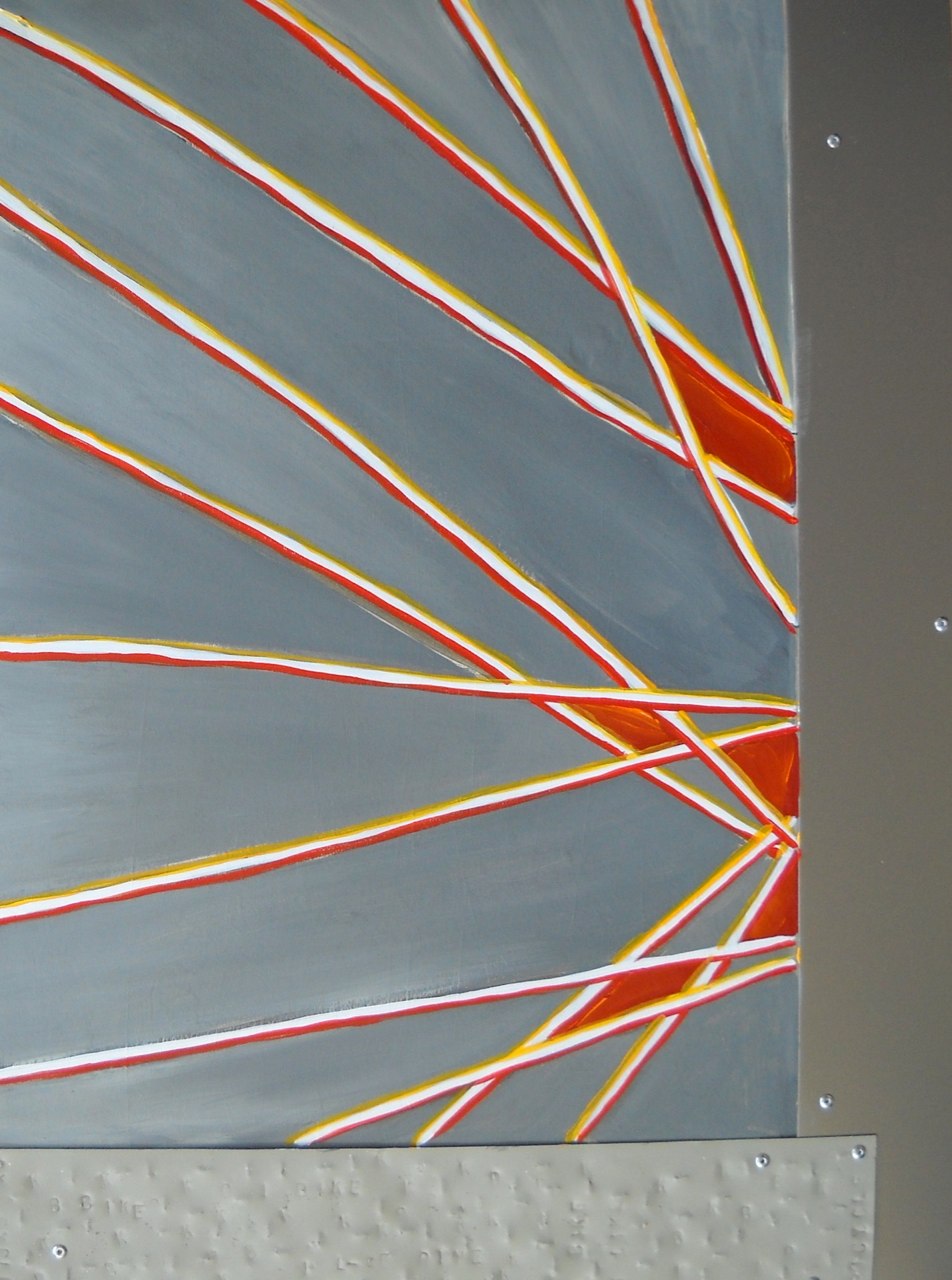
Amy: Yeah, you're right.
I find that I produce something and maybe it was inspired by another artist but it never looks like their work. It's still me, it's still my hand.
Peggy: So what or who inspires you?
Amy: Georgia O'Keeffe has always been a favorite. I loved her work and loved her spirit too and I love the desert and her years that she spent out there wandering around on her own. That sounds beautiful to me.
Peggy: Have you been to Santa Fe?
Amy: No, I haven't been there but I've been to a lot of those southwestern states . But I haven't been to Taos, specifically. I went to see a show at SFMOMA and it was Georgia O'Keeffe and Ansel Adams, and I had never seen her work before. I happened to be picking up at friend at the San Francisco Airport so I was by myself, it was this very rare moment. I went just to see this show. And I walked in and just got overwhelmed by emotion. I didn't expect that at all. I like Ansel Adams but his work wasn't as moving to me. I had to get up close to her painting and look at the brushstrokes and everything. And there were computers set up in another room where you could sit down and listen to interviews with them from years ago. In one part of the interview with Georgia O'Keeffe—I can't remember what the question was, but she just said that she didn't think she was the best painter out there. She said, "I'm not the best there is, there are plenty more people who paint better than I do." She said, "I just got lucky with my timing that people liked what I was doing at the time I was doing it." And for me this was an epiphany—oh yeah I don't have to be the best painter ever. You know I think I felt like that, that I had to be so much better than other people in order to be a valid painter. And then I started thinking about all the arts, music specifically—how many people are successful musicians and don't really have great voices but they just had the balls to go for it and love what they're doing and make it work. And half of it is because they know that's what their role is on the planet while they're here. So I felt like, wow, if she feels like that, then certainly I can do that too, doing my best at what I can do in this moment.
Michael: And probably the key is that you're doing it, instead of just sitting here fretting over how you should be doing it.
Amy: Yeah that's true. I feel like I'm just starting to find my voice. Because painting really sporadically for 20 years doesn't do much to move forward. So currently I'm really drawn to all the Fauvist painters and I'm finding that my work is going that way. I'm not using color so realistically anymore and I'm really having more fun with it. I'm painting more landscapes than I thought I would, I don't know why I didn't think I would.
Amy: I went to see the show that was at the end of the Plein Air Festival this year. There were like 50 artists and there were maybe 2 that were appealing to me, all the others looked so much the same. They were technically very proficient and they're beautifully done, but there's something about the Fauvist idea that also brings out the emotion of the person viewing it at the time. I mean you could capture that beautiful scene in a photograph but when you paint it I want to see the details a little differently or feel something more than oh wow that's pretty. I don't know.
Peggy: So that's interesting coming from a landscape architect. But Michael, you commented the other day that Amy's pictures focus on things that people might miss.
Michael: Yeah, I see a small part of everyday life. Your paintings elevate a small simple aspect of the world we live in. That to me is what art is, encouraging people to really see —
Amy: —what's right in front of them! Yeah one of the Plein Air paintings, one that I was really drawn to, was a picket fence in front of a house in really bright colors. The main subject was the fence, it wasn't this long view. Yeah, whether I'm painting botanical stuff or landscape, those are the things that are most interesting to me, these everyday items or details of the world around you that you don't necessarily look at as beautiful—but they are.
Michael: Do you ever get stuck? Do you ever have to break through a barricade in your mind about what to do?
Amy: Not very often. I think it's because I'm not out here every day all day long. Maybe if it was a full-time gig, 40 hours or whatever—but because I'm a parent and working another job and running the house, I have more ideas than I have time for and I get little 3 hour blocks and I can easily fill that. No problem. I haven't really allowed myself much time to screw up. I just don't have time. But when I do it's not pretty. Like this piece here with the orange. I did it and then I wasn't moved by it at all. And I started messing with it and it just got worse. I probably just should have put it in the trash.
Michael: Sometimes you just need to keep it there in the corner, your nemesis. And maybe in 5 years it'll just come to you. So don't sweat it.
Amy: I feel like it's bad feng shui or something, to have it in the room.
Michael: What about promotion of your work? You have an ETSY site, what else do you do?
Amy: I wish I had representation. I wish I had somebody who was comfortable with marketing and doing it for me. I know a lot about branding and the graphics side of it, I can make my little postcard ad look awesome, but I'm not a very good self-promoter. Most artists that I know have a hard time with that. For the next week or two before Christmas I have a little open studio, and I was talking to a group of mothers the other day and I was just getting ready to send out an email to them and other parents—other women I know who might be interested—and one of them was complaining about all of the marketing emails she's been getting since Thanksgiving, and I thought, "oh no!" That was over a week ago. I'm still going to send it out. But I don't feel comfortable doing it. I really admire the people just putting something out there. The voice that they have behind their work just makes you feel like what they're doing is important. I don't know how to do that.
Michael: This touches on what you talked about earlier, your sense of self confidence. That informs your ability to go out there and blow your own horn.
Peggy: And we've found that a lot of people have a partner who does that for them or they hire a rep or a consultant. It's pretty rare that the artist has the attitude or aptitude to rep themselves.
Amy: It's like different parts of your brain. Have you heard of Sylvia White, down in Ventura? She has a gallery down there and she's not an artist herself but she's supported artists, including her husband, for 35 years. She's a real straight shooter, she'll tell you that's a waste of time, which shows to enter, she just has that kind of drive.
Peggy: Does she rep other people?
Amy: I guess via the gallery.
Peggy: Has Sylvia White coached you?
Amy: I'm part of Sylvia's email list, she'll send out inspirational stories, and she'll attach opportunities she's come across. I went to Ventura once to meet with her and a group of other artists. She was trying to get us all together to help each other.
Michael: What's the name of her gallery?
Amy: Sylvia White gallery. I thought it sounded like a great idea connecting with other artists. I would like to look north or south, probably south first, Ventura or Santa Barbara over the next several years to get some exposure down there. So it seemed like a good move, but it was just a group of people just like me. Nobody wanted to step up and take control and be in charge of the group and motivate each other. It was just a group of 30 introverts without a leader. It didn't really go anywhere. But I just appreciated her personality and saw that someone like her would be helpful for sure.
Michael: The last interview we did was with Randy Stromsoe. One of the questions we always ask and you're going to get this later so put this in the back of your mind. What advice would you give to someone who's starting out just trying to make this happen. And his response was a little different from what I'd heard from others. His response was that the best thing you can do is to go out and look around at other artists who do work similar to yours, especially people who are succeeding at it. See where they are and go there—go to those galleries, go to those cities. It may be on the other side of the country, but go there because that's where there's a market for what you do. And we tend to think in terms of, "well here I am in my location and I need to go see if I can find someone around here who is interested." But they may in fact not be around here. It doesn't mean that no one is interested, you're just in the wrong spot, you're in a good spot for your creativity but not for selling your art. His idea was to look in the journals, look on the web, look anywhere you can find publicity about artists who are showing somewhere who are doing well, who have a name, and do work similar to your own, and use that as kind of a template for finding your own place to show. I don't know if I'm asking you a question or just making a comment, do you have any thoughts about it?
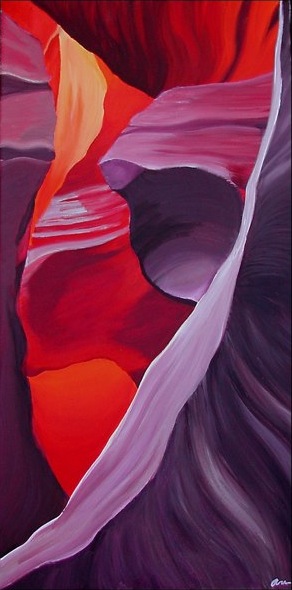
Amy: I did a series of paintings of slot canyons and people here don't even know what they are. Not that you have to know what they are to like it. But I've often thought if I do any of those again I should probably try to get them in galleries in Sedona or something. I mean it's the reason that Morro Rock sells and sells around here. And please shoot me if I paint Morro Rock. It's been done, really well. But I don't know. I live here and I love it and it's beautiful but the ocean doesn't inspire me. That's just not my thing. So yeah I can definitely see that it makes sense. I wish I had the means to take my work to other states. But you know I've also found that just painting in this space I started to paint that (points to a painting of a field), even though that wasn't the intent. And that's been appealing locally. And that's good because I was in the spot where I was thinking I don't want to paint just what I think will sell just because I think it will sell. But at the same time you don't want to spend hours and hours painting things that people don't understand.
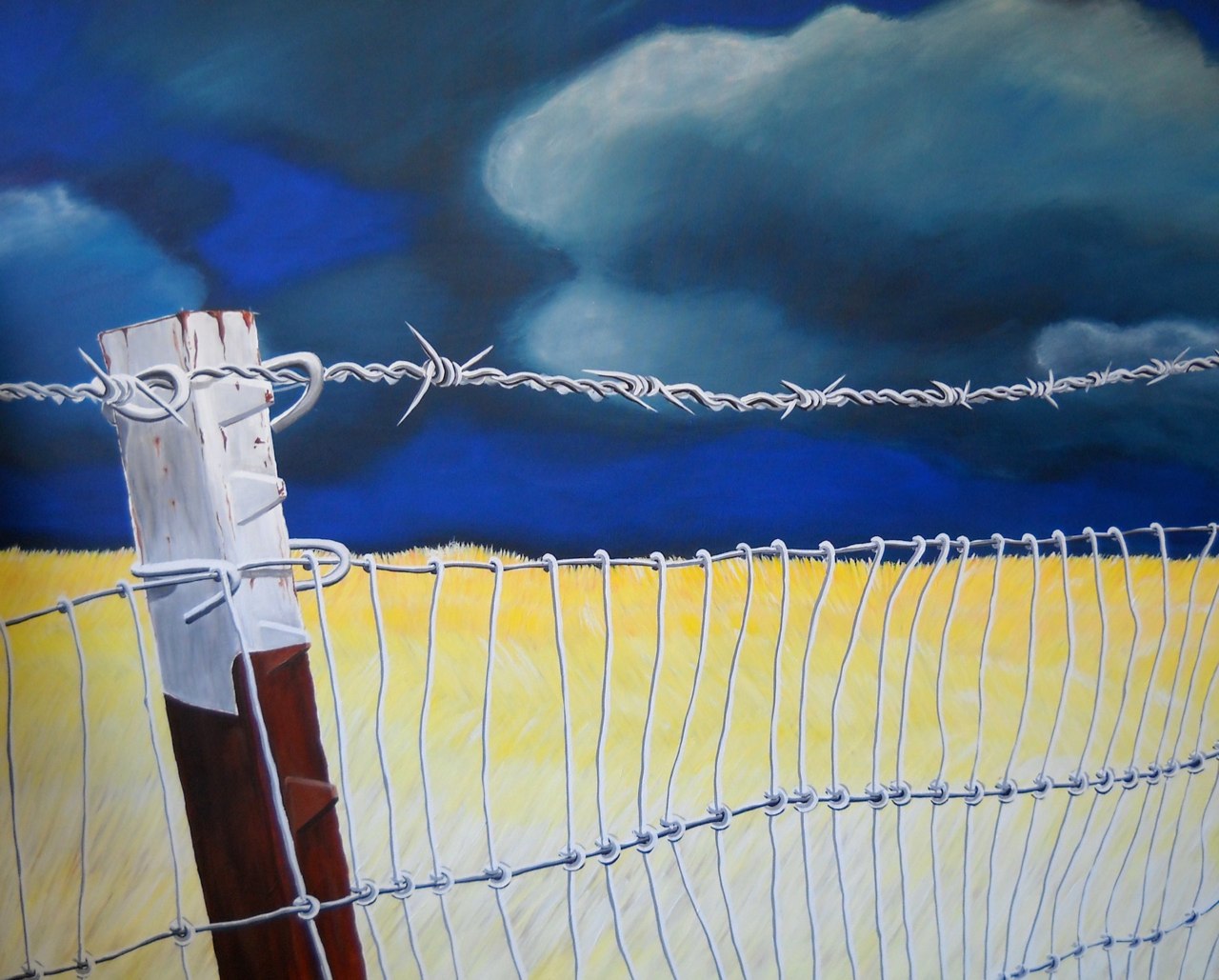
Michael: That's probably the biggest challenge and consternation of artists everywhere—the balance between finding some kind of recognition and acceptance of your work and expressing what's in your core. If you haven't really found anyone who gets what you're doing, does that mean you shouldn't do it? That's a hard place to be if that's the case.
It's a basic human need to be appreciated.
Amy: I feel like I've found a space where I'm inspired by what's around me for sure. Not that those other ideas won't come later.
Peggy: You've sold things through the shows. At the ETSY site you have paintings and the bags, cards, etc., Do you sell much?
Amy: Not much, ETSY is really over saturated, I have no idea how many vendors are on it but it could be hundreds of thousands. I have a friend who's a seamstress who does kids clothing. She does burpee rags and clothes and all kinds of beautiful things. She does really well and other boutiques have found her. She's shipping around the world. But she does that all the time and she's always posting new items. She advertises, and you have to engage in it in one way or another almost every day. When you pull up the Etsy site there's a homepage and there's kind of a scrolling list. There's the featured and new items rotating through at the top. And then if you're lucky you get featured on the front page. But I don't have the time. So if someone wants to buy something it's a way they can do it remotely. It's been helpful but it's not huge.
Michael: Are there any other online venues that have caught your eye.
Amy: Fab.com. It's a little of everything. Any sort of design work. It's everything from cool artsy magazines to handprinted tea towels. Anything you can think of. So I've thought about that for my jewelry but at the same time I don't want to spend all this time trying to market prints and jewelry when I'm supposed to be painting. So the whole point of the small stuff is just because I think most people appreciate art at some level and most people can't afford it. That doesn't mean it shouldn't be in our everyday lives and that we shouldn't use it and give it and be able to be a part of it, so yeah I have to pull myself in sometimes. That's just a side thing and I've got to keep painting.
Michael: You mentioned this group in Ventura that hasn't really gotten going. Let's talk a little bit about the connection with other artists and what role that plays for you, if it does.
Amy: When I first started going out and looking for shows, I was really looking for a group of people around my same age who were also trying to make a go of it. I haven't really found that. A lot of the people locally who are my age are not in my similar position, a lot of them are single, and they live a totally different life, they can spend three days painting non-stop or something without interruption and not sleep. I can't relate to that at all because I get three hours if I'm lucky. It's more about finding this balance between my family and my work and sometimes just feeling overwhelmed—but I think all mothers feel that way.
And then I was a member of the Art Center [Former name of San Luis Obispo Museum of Art] for awhile, years ago, but every time I went to a meeting I found that I was in the minority. It was mostly women over 60. And good for them, but that wasn't what I was looking for either. I wanted to be around younger people who were doing more contemporary work. I haven't found that group yet. But there are local artists that I'm inspired by that are in a similar scenario. Lena Rushing, do you guys know her work?
Peggy: Is she the one who curated the show at Linnea's?
Amy: Yes, the "Mincing Words" show. She's a stay at home mom so I don't know if she relies on art sales for an income but she drives a minivan and she's got two kids at school about the same age. And she's still painting on a regular basis and making that work, she does beautiful stuff. And there's another guy who did one of the utility boxes downtown, Justin Johnson.
Amy: He's a Dad, same age as me, they have two kids and when I see their work, and I mentioned Anthony Hansen earlier, those people just inspire me to keep going.
Michael: Are they people you're in contact with?
Amy: Not necessarily, Lena just because the couple of pieces I have at Linnea's now. She was hanging as well and once in a while we'll email each other with a question about something new or something were both involved in.
Amy: And Anthony is a friend, although we don't get together that often. But he came in the first time I did Open Studios here, he had his work here so he kind of supported me with that. That was 6 years ago. But it's not like I meet once a month with some other painter friends.

Peggy: Do you know Dan Berkeland the painter, the baker, personally?
Amy: Just through the bakery—the Back Porch Bakery. Now his Morro Rock is just stunning. That, I would hang in my house. Yes and again he's got the bakery and two little girls and he's painting.
And I appreciate him too. I feel like he's my male counterpart. (laughing) He studied architecture at Cal Poly and I did landscape architecture and now he's doing this baking and I had a cupcake bakery for a while. It's kind of like creative ADD. We've got to have our hands in everything just a little bit, or a lot, at least until we burn out.
Michael: So where do you see yourself going from here?
Amy: That's a good question. I think I'd like to look outside the community. Not that I've exhausted SLO County. I haven't even gone to North County. I intend to check out Studios on the Park. Having more eyes on my work would be of benefit. I'd love to be picked up by a gallery or something and then I think I'll also look into the fairs, like local art and craft fairs. But I sort of need a year to just visit them and take notes and figure out what would be a good fit for me. I don't want to be next to the lady who's crocheting kleenex box covers. I want to find something that seems like a good fit.
Michael: There are shows like that that would be a good fit. But as Randy pointed out in that other interview, they're not necessarily right here. There's an amazing show in Sausalito. Bellevue Washington is really good. These may be craft shows in name but they're serious art shows. Shows with masters of their craft.
Amy: You;re not talking about crafty craft.
Michael: Not hobby shows.
Amy: My friend Anthony—those shows are his bread and butter. He'll go to Sausalito and someone will buy six pieces from him. And nine months out of the year he's traveling for those shows.
Michael: So that's a lifestyle choice. And you're in a position where that's not an easy thing to do.
Amy: No it's not now. So that's why I'm thinking about the local shows that might be doable and wouldn't be financially prohibitive, like Santa Barbara—something I can do in a day. I think long term that's where I'm looking. And just to keep doing it. I feel like the work I'm doing just getting shown locally is moving me forward in leaps and bounds. Just in feeling good about the work that I'm doing—and then I can take that confidence and go out from there.
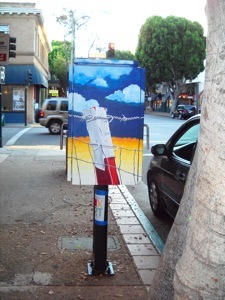
Peggy: How did you get the utility box?
Amy: You submitted up to 3 concept ideas with your application and write an essay to describe your concepts and why they'd be suitable. I think 33 artists submitted and 16 were chosen. So that felt good too.
Peggy: And you got a prime spot.
Amy: That wasn't my original spot, the original was Marsh and Nipomo. There's not a lot of pedestrian traffic there and then at the last minute I got moved. But to have a permanent installation is huge.
Amy: Let's go back to something you said earlier. This might be a good response to what advice I'd give to other artists. I decided that if this is what I wanted to do, if I wanted to be a full-time artist, that I had to act like I already was. If this was my only job, and I had already made it, already got the exposure and validation and all that, what would I be doing? And part of it was telling people I was an artist, which was hard to say at first. You know I'd meet people and in chit chat, they would ask what I do. I started forcing myself to first say I'm an artist and then a designer and I work at RRM as well. That was really hard. I felt like I was faking it.
Peggy: The impostor.
Amy: Like someone would call me out. But it's also a self marketing thing too. There are parents I see everyday at school at pick up who don't know what I do because I don't talk about it. And then someone will find out because I can't go wine tasting with the ladies because I'm painting. Painting? Tell me more. What?
So that's been part of it, just pretending that I'm already there. And it really makes a huge difference. Working regularly is important too. I was just telling Lief the other day that when I'm producing here it's like that energy goes out into the world and then I'm selling. And then when there's a break of time when we're busy with family or whatever and I'm not out here, nothing happens. I don't just get a random call that somebody wants something. But I did a little show with these panels. I had 12 of them and I was making jewelry and during that month I got a call out of the blue to do a commission and then another. There were two commissions and a couple other things fell into my lap at the same time. So I just feel like if I keep working then I keep selling. But for some reason when I'm not actively pursuing it, nothing happens. So that would be my advice - just pretend you're already a full time artist and you've already made it and you've already got people who want your work and you just need to produce.
Michael: Wow, that's great. The only other question I have, is have you had any clutch moments when you thought you should have done something different? Do you ever wish you could get a do-over?
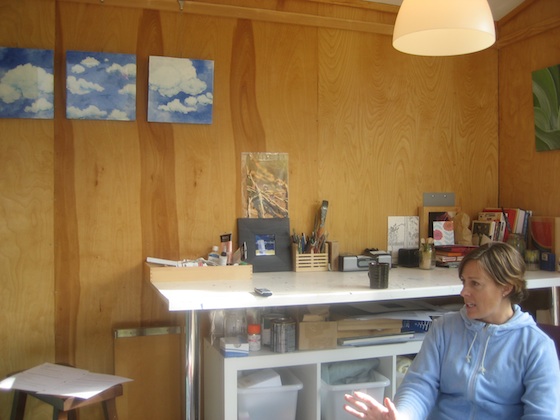
Amy: For a while I thought, "If only I had gone to art school." I don't have that formal training and background. But now I feel like I am who I am today because of where I've come from. Because I studied landscape architecture and because I worked in that industry for 12 years. And it might not have worked out if I went to art school. Maybe I would have just ended up frustrated. You know, maybe the timing wasn't right. I didn't have the confidence I needed to get an art degree and then go out in the real world and try to make a living doing that. I may have just been beaten down really easily and just walked away from it. And maybe become totally disenchanted with it, I don't know.
Michael: It's a good healthy answer. You are who you are because of what you've been, because of what you've done.
Amy: And it certainly has an influence on me in my work. So I feel like everything happens when it's supposed to and the universe has been responding well to me right now. I think this is when it was supposed to happen. No regrets.
Michael: That's great.
Amy: Trying to live in the moment as much as possible
Michael: I see you have Eckhart Tolle's A New Earth over there.
over there.
Amy: In the now. Which is key when you have little kids too, they grow up so quickly. And it's hard to just sit on the floor and play a game with them and not be thinking I should put some laundry in and be doing other things.
The kids are my biggest fans. Every time we go by the utility box they go Mom, there's your box. It's still there. I did some graphic design for a movie, a surf movie, Women and the Waves. And they showed it at the local film festival a couple of years ago and I took Ian to see the movie. And we're sitting there waiting for it to start and he turns to the guy next to him and goes "My mom made this movie." I'm like no, no thank you though buddy.
Peggy: He needs to be your rep.
Amy: Yeah, "My mom's a painter." Yeah I should tell him to get out the word.
Amy: Are you guys going to talk about pricing at some point in Outside the Lines?
Michael: The short answer is yes. But this is your platform. What are you thinking?
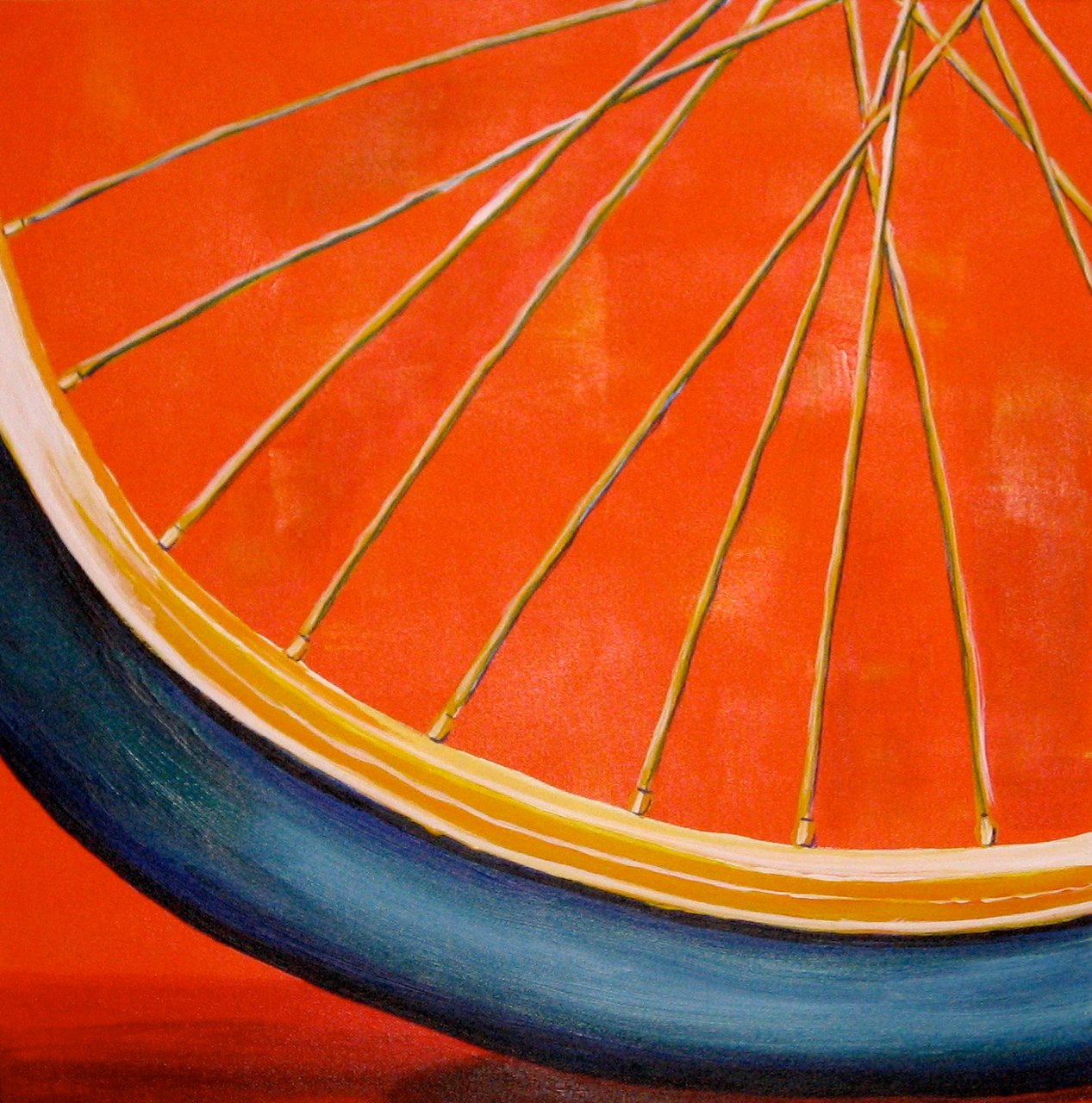
Amy: Well I looked around a lot I went to shows and galleries to see what other people were charging and like you were saying I looked at work that I thought was similar to mine in one way or another. I originally got advice from Lynn Kishiyama, in Paso Robles. I went to a workshop with her and she said a dollar per square inch. And that's definitely where some people are but then when I actually started working regularly and showing, I just felt like nobody's got that kind of cash right now and there's no point having a stack of paintings that I don't have room for because I priced them too high. If it's $2500 vs. $1200 maybe someone can do $1200. So I just kind of started looking around more and just pulling out costs like what I think would be reasonable. However, I had some advice from Matthew Moerman at Baxter Moerman, the jeweler next to San Luis Art Supply. I put some jewelry in a show they had, and was asking about pricing. He said he had to stop pricing based on his own budget. He said, "I can't afford anything in my own store but that doesn't mean that there aren't people who can." I have a pair of earrings that are $35 but if they're in sterling they have to be $65 and maybe that's a little too much for me but not for a lot of people. So I'm trying to get out of my head about that. I think that's currently my most helpful advice.
Michael: This is a huge issue and yes we do need to write about it.
Amy: There's still such satisfaction for me to sell something because it doesn't really matter what I get for it it's more that my work felt good to somebody.
Luckily most of the materials I work with aren't very expensive, so I definitely recover my costs and I guess most of the time, my time. I'm not making a ton but I feel like when my prices are reasonable I sell more easily. So I sell smaller pieces. I could sit around and wait forever for a piece to sell that's $2000 or I could sell at a cheaper price more often. I really like big canvases.
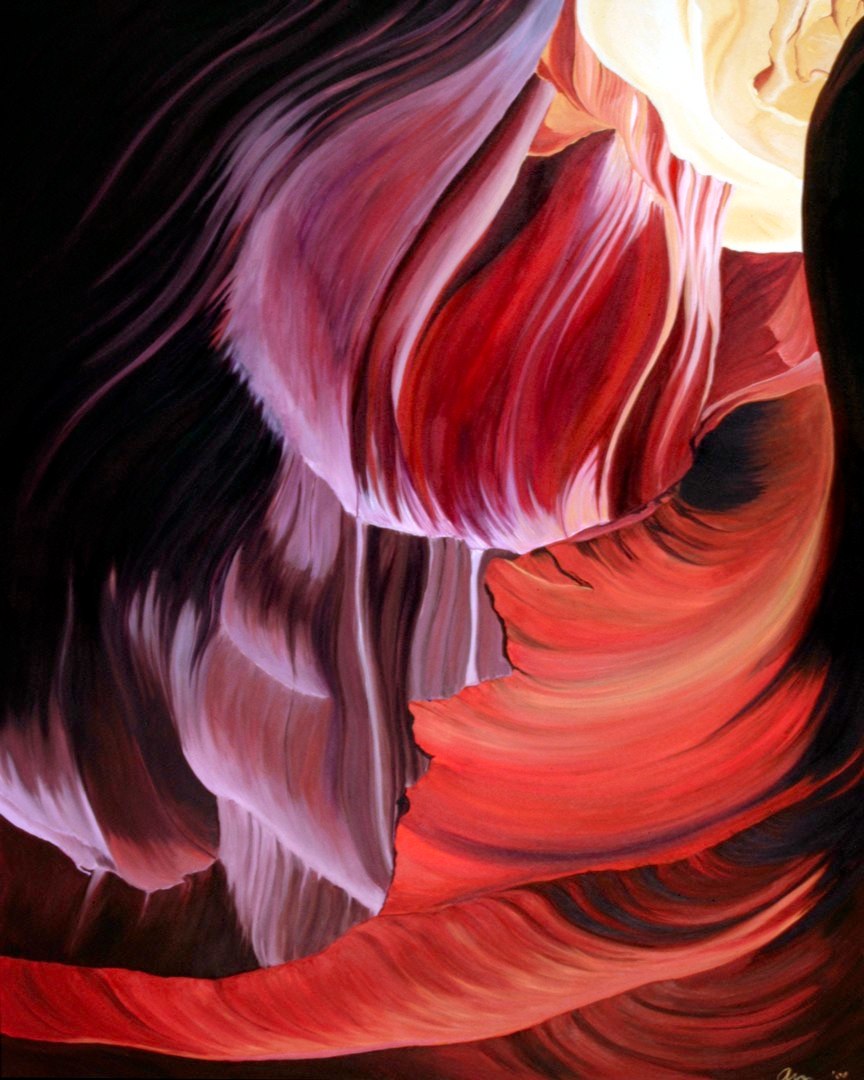 So I did this big Slot Canyon 48 x 60 and I had it in the gallery in Avila. And a woman was interested and I had this piece at the Art Center and it was $2800 6 years ago. And later, when I had it in the gallery I had it at maybe $1200 or $1100 or something. And this woman was interested, she said she wanted it, the gallery owner took it to their house and they couldn't fit it anywhere in the house. She gave it back and six months later the gallery owner called me and said they got a new house, a vacation home in Ventura and they wanted it now.
So I did this big Slot Canyon 48 x 60 and I had it in the gallery in Avila. And a woman was interested and I had this piece at the Art Center and it was $2800 6 years ago. And later, when I had it in the gallery I had it at maybe $1200 or $1100 or something. And this woman was interested, she said she wanted it, the gallery owner took it to their house and they couldn't fit it anywhere in the house. She gave it back and six months later the gallery owner called me and said they got a new house, a vacation home in Ventura and they wanted it now.
Michael: They bought a house for your painting!
Amy: Later we were at a Christmas party and I saw the gallery owner there with this woman and her husband. She and I hadn't met since the show the year before. My girlfriends and I had noticed her on the dance floor. She was such a good dancer, and wow, look at how she moves! We just wanted to keep watching. She was so excited to find out I was there and gave me this big hug and she said when she first saw the painting she said it made her feel like she does when she dances. It doesn't matter what she paid for it. I'll never forget that. I'd much rather find homes for work than hold on to it because I didn't get the right dollar amount.
Michael: Your story really illustrates the impact of the economy. We're seeing that a lot of people are making creative choices because the practical choices aren't working. That's an interesting dynamic unfolding these days in our world.
Amy: I think also for me it kind of gave me a new perspective on life in general, the bigger picture. I wasn't working and I didn't know when I was going to work again. Financially things weren't going like we had planned and three years ago we didn't think we'd be here right now. So what do we do? But in those moments when you're lying in bed at night wondering how it's all going to work out—you know Eckhart in the back of my head: I'm ok right now, I have a roof over my head, my family is healthy and we're happy together and I live in this beautiful place, and we have food every day. It's these simple things and this reality check—I've got to do this now. Why wait? Seizing the day!

| 
 Amy McKay was on a traditional career path in landscape architecture until the economy threw her, and the entire construction and architectural design industry a curve beginning in 2008. She followed that curve right into her life's passion and is now painting in her own studio space and showing and selling regionally. Her story is about closed doors. Her story is about opening your own doors. The choices Amy is making add up to a remarkable example for artists trying to find their way in this tough economy.
Amy McKay was on a traditional career path in landscape architecture until the economy threw her, and the entire construction and architectural design industry a curve beginning in 2008. She followed that curve right into her life's passion and is now painting in her own studio space and showing and selling regionally. Her story is about closed doors. Her story is about opening your own doors. The choices Amy is making add up to a remarkable example for artists trying to find their way in this tough economy.










 So I did this big Slot Canyon 48 x 60 and I had it in the gallery in Avila. And a woman was interested and I had this piece at the Art Center and it was $2800 6 years ago. And later, when I had it in the gallery I had it at maybe $1200 or $1100 or something. And this woman was interested, she said she wanted it, the gallery owner took it to their house and they couldn't fit it anywhere in the house. She gave it back and six months later the gallery owner called me and said they got a new house, a vacation home in Ventura and they wanted it now.
So I did this big Slot Canyon 48 x 60 and I had it in the gallery in Avila. And a woman was interested and I had this piece at the Art Center and it was $2800 6 years ago. And later, when I had it in the gallery I had it at maybe $1200 or $1100 or something. And this woman was interested, she said she wanted it, the gallery owner took it to their house and they couldn't fit it anywhere in the house. She gave it back and six months later the gallery owner called me and said they got a new house, a vacation home in Ventura and they wanted it now.


